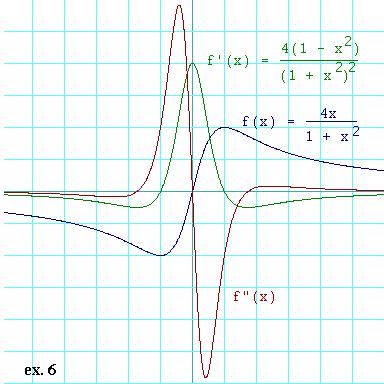

This problem involves finding both the first and second derivatives of
4x
f(x) =
1 + x2
and, as stated before, you will need to use both the
quotient rule and the
chain rule to determine them.

Here is a graph of the function and its first and second derivatives. The function itself is shown in blue, the first derivative in green, and the second derivative in brown.
To find maximums and minimums we must first determine the first derivative. Because f(x) is the quotient of two polynomials, we need to use the quotient rule in order to find f'(x).
To use the quotient rule, you need to separate f(x) into a
numerator function, n(x), and a denominator function, d(x).
In this case, if we let
n(x)
f(x) =
d(x)
You can quickly determine that The quotient rule tells us that
d(x)n'(x) - n(x)d'(x)
f'(x) =
d2(x)
If you substitute the expressions we have for n(x), d(x),
n'(x), and d'(x) into the above, you get
4(1 + x2) - 8x2
f'(x) =
(1 + x2)2
And when you gather up like terms in the numerator, you get
4(1 - x2)
f'(x) =
(1 + x2)2
We know that, by definition, the stationary points are where
1 - x2 = 0This happens only when
In order to know whether these points are maximums or minimums, we must
determine f"(x). To do that, we have to take the derivative of
f'(x), which again is a quotient. So again we have to apply the
quotient rule. This time we have
To apply the quotient rule, we need to know both n'(x) and
d'(x). You should quickly be able to determine that
-(1 + x2)2(8x) - 16x(1 - x2)(1 + x2)
f"(x) =
(1 + x2)4
It's starting to look nasty, eh? But go ahead and multiply out the numerator,
then gather up like terms, and you get
8x(x4 - 2x2 - 3)
f"(x) =
(1 + x2)4
And we're in luck because that 4th degree polynomial (that appears as the
second factor in the numerator) can be factored. Think of it as a
quadratic in x2. What you get is
8x(1 + x2)(x2 - 3)
f"(x) =
(1 + x2)4
And as a reward for you're having led a clean life, lo and behold,
we get a cancellation
8x(x2 - 3)
f"(x) =
(1 + x2)3
Now we can get back to using this to determine whether the stationary
points of f(x), which we already determined happen at
Likewise, you can determine that
If you glance at the graph, you will be able to see the two lobes of the
blue trace do form a minimum and a maximum at
But what about finding those inflection points? Well, we have to determine where f"(x) is zero. Again, this f"(x) is a quotient, and with quotients, it is sufficient to find where the numerator is zero (provided the denominator is continuous and not equal to zero at the same x value).
Here the numerator is
_
x = ±Ö3
All three of these are inflection points. You cannot be absolutely sure of that unless you go to the fourth derivative and make sure that it is not zero at any of these points, but you are very unlikely to be tested on that. Also, it is clear from the graph that the slope of f"(x) is nonzero at each of those three points. And that can make you as sure as you need to be.
email me at hahn@netsrq.com